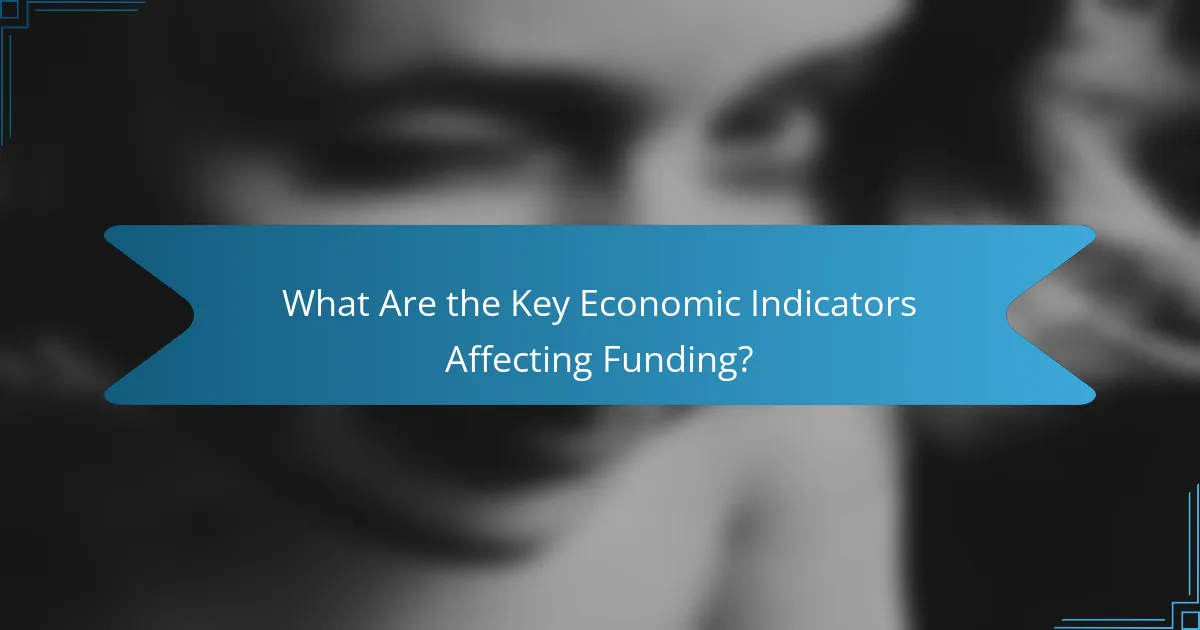Economic conditions play a crucial role in shaping the funding landscape for human rights organizations in the UK. Fluctuations in financial resources and donor priorities during economic downturns can severely limit these organizations’ ability to operate and advocate for human rights effectively.

How Do Economic Conditions Impact Funding for Human Rights Organizations in the UK?
Economic conditions significantly affect funding for human rights organizations in the UK by altering the availability of financial resources and shifting donor priorities. During economic downturns, organizations often face increased competition for limited funds, which can hinder their operations and impact their ability to advocate for human rights effectively.
Increased competition for limited resources
As economic conditions tighten, human rights organizations find themselves competing for a shrinking pool of funding. This competition can lead to a situation where only the most established or well-connected organizations receive support, leaving smaller or newer entities struggling to secure necessary resources.
To navigate this increased competition, organizations should focus on building strong relationships with potential donors and demonstrating their impact through clear metrics and success stories. Engaging in collaborative projects with other organizations can also enhance visibility and attract funding.
Shifts in donor priorities
Economic challenges often lead donors to reassess their funding priorities, which can impact human rights organizations. Donors may shift their focus to immediate needs such as health care or economic recovery, sidelining human rights issues that may seem less urgent.
Organizations must adapt to these changing priorities by aligning their missions with current donor interests. This could involve emphasizing the intersection of human rights with economic stability or public health to appeal to a broader range of funding sources.
Government budget cuts affecting grants
Government budget cuts can significantly impact the availability of grants for human rights organizations in the UK. Reduced public funding often leads to fewer grants being awarded, forcing organizations to seek alternative funding sources.
To mitigate the effects of government budget cuts, organizations should diversify their funding strategies. This includes exploring private donations, corporate sponsorships, and international grants. Additionally, staying informed about government funding opportunities and advocating for the importance of human rights funding can help secure necessary resources.

What Strategies Can Human Rights Organizations Use to Secure Funding?
Human rights organizations can secure funding by implementing diverse strategies that enhance their financial stability and outreach. Key approaches include diversifying funding sources, building partnerships with corporations, and leveraging social media for effective fundraising.
Diversifying funding sources
Diversifying funding sources is crucial for human rights organizations to reduce reliance on a single donor or funding stream. This can involve seeking grants from various foundations, government agencies, and international organizations, as well as individual donations and crowdfunding campaigns.
Organizations should consider a mix of public and private funding, aiming for a balanced portfolio. For example, they might allocate 30-50% of their budget to grants, while the rest comes from donations and events. This strategy helps mitigate risks associated with funding fluctuations.
Building partnerships with corporations
Establishing partnerships with corporations can provide human rights organizations with significant financial support and resources. These partnerships can take the form of sponsorships, cause-related marketing, or employee engagement programs that align corporate social responsibility with the organization’s mission.
When approaching corporations, organizations should clearly articulate the mutual benefits of collaboration, such as enhanced brand reputation for the company and increased visibility for the cause. Engaging in joint initiatives or campaigns can also create shared value and foster long-term relationships.
Leveraging social media for fundraising
Social media platforms are powerful tools for human rights organizations to reach a broader audience and raise funds effectively. By creating compelling content that resonates with followers, organizations can encourage donations and increase awareness of their causes.
Strategies include running targeted social media campaigns, utilizing live fundraising events, and sharing impactful stories that highlight the organization’s work. Organizations should also engage with their audience through regular updates and interactive content, which can significantly boost donor engagement and retention.

What Are the Key Economic Indicators Affecting Funding?
The key economic indicators affecting funding for human rights organizations include unemployment rates, inflation rates, and GDP growth. These factors can significantly influence the availability of financial resources and donations, impacting the operational capacity of these organizations.
Unemployment rates
Unemployment rates directly affect disposable income and charitable giving. When unemployment is high, individuals and businesses may have less financial flexibility to donate, leading to reduced funding for human rights organizations.
For example, during economic downturns, many donors may prioritize essential expenses over philanthropic contributions. Organizations should monitor unemployment trends to anticipate potential funding challenges and adjust their fundraising strategies accordingly.
Inflation rates
Inflation rates impact the purchasing power of donations and the operational costs for human rights organizations. Higher inflation can erode the real value of contributions, making it more difficult for organizations to sustain their programs.
Organizations may need to adapt by seeking funding sources that are less sensitive to inflation, such as long-term grants or endowments. Additionally, they should consider adjusting their budgets to account for rising costs, ensuring that they can continue to meet their mission despite economic pressures.
GDP growth
GDP growth reflects the overall economic health of a country and can influence funding availability for human rights organizations. A growing economy typically leads to increased corporate profits and individual wealth, which can result in higher levels of charitable giving.
Conversely, stagnant or declining GDP can lead to reduced funding opportunities. Organizations should focus on building relationships with donors during periods of growth and prepare for potential downturns by diversifying their funding sources to mitigate risks associated with economic fluctuations.

How Can Human Rights Organizations Adapt to Economic Challenges?
Human rights organizations can adapt to economic challenges by implementing strategic measures that enhance financial sustainability and operational efficiency. These adaptations may involve cost management, strengthening relationships with donors, and improving communication through compelling narratives.
Implementing cost-cutting measures
Cost-cutting measures are essential for human rights organizations facing economic constraints. Organizations can assess their budgets to identify non-essential expenses and prioritize funding for core activities that align with their mission.
Consider options such as reducing overhead costs by negotiating better rates for services or utilizing technology to streamline operations. For instance, transitioning to remote work can lower facility expenses while maintaining productivity.
Enhancing donor engagement
Strengthening donor engagement is crucial for securing ongoing support. Organizations should focus on building relationships with existing donors through regular updates and personalized communication, which can foster loyalty and encourage larger contributions.
Utilizing social media and email campaigns to share success stories and impact reports can also attract new donors. Consider hosting virtual events or webinars to engage potential supporters and showcase the organization’s work effectively.
Focusing on impactful storytelling
Impactful storytelling is a powerful tool for human rights organizations to connect with audiences and donors. By sharing real-life stories of individuals affected by human rights issues, organizations can evoke empathy and inspire action.
Utilize various formats, such as videos, blogs, or social media posts, to reach a broader audience. Highlighting specific cases and outcomes can demonstrate the organization’s effectiveness and the importance of continued support, making it easier for donors to understand the value of their contributions.

What Role Do Government Policies Play in Funding Availability?
Government policies significantly influence the funding landscape for human rights organizations by determining the allocation of public resources and setting the regulatory environment for private donations. These policies can either enhance or restrict the financial support available to these organizations, impacting their ability to operate effectively.
Impact of austerity measures
Austerity measures often lead to reduced government spending on social programs, including those that support human rights initiatives. When budgets are tightened, funding for grants and public sector partnerships typically diminishes, forcing organizations to seek alternative funding sources.
Human rights organizations may face challenges in maintaining their operations during periods of austerity. They might need to diversify their funding strategies, such as increasing outreach to private donors or exploring crowdfunding options to fill the gaps left by government cuts.
Changes in international aid
International aid can fluctuate based on geopolitical considerations and donor countries’ economic conditions. Changes in government policies in donor nations can lead to increased or decreased funding for human rights organizations operating in various regions.
Organizations must stay informed about shifts in international aid priorities and adapt their strategies accordingly. For instance, if a country reduces its aid to a specific region, organizations may need to pivot their focus to align with the interests of other potential funders.
Regulatory frameworks affecting donations
Regulatory frameworks play a crucial role in shaping the donation landscape for human rights organizations. Laws governing tax deductions for charitable contributions can incentivize or dissuade individual and corporate donations.
Organizations should understand the local regulations that affect their fundraising efforts. For example, in some countries, tax benefits for donors can significantly increase the likelihood of receiving contributions, while in others, stringent reporting requirements may deter potential supporters.

What Are the Long-Term Trends in Funding for Human Rights Organizations?
Long-term trends in funding for human rights organizations indicate a shift towards more diverse and sustainable funding sources. Economic conditions, donor priorities, and societal movements significantly influence these funding patterns, leading to both challenges and opportunities for organizations in this sector.
Shift towards grassroots funding
Grassroots funding has gained traction as traditional funding sources become more competitive and less predictable. Many human rights organizations are now turning to local communities for support, fostering a sense of ownership and engagement among donors.
This shift often involves small donations from a larger number of individuals rather than relying on a few large grants. Campaigns that emphasize community involvement and transparent use of funds can effectively mobilize support, especially in times of economic uncertainty.
Increased reliance on digital platforms
Digital platforms have become essential for human rights organizations to raise funds and engage supporters. Online crowdfunding, social media campaigns, and virtual events allow organizations to reach a global audience, often with lower overhead costs compared to traditional fundraising methods.
Utilizing these platforms effectively requires a clear strategy, including compelling storytelling and targeted outreach. Organizations should consider leveraging analytics to understand donor behavior and optimize their campaigns for better engagement and funding outcomes.



